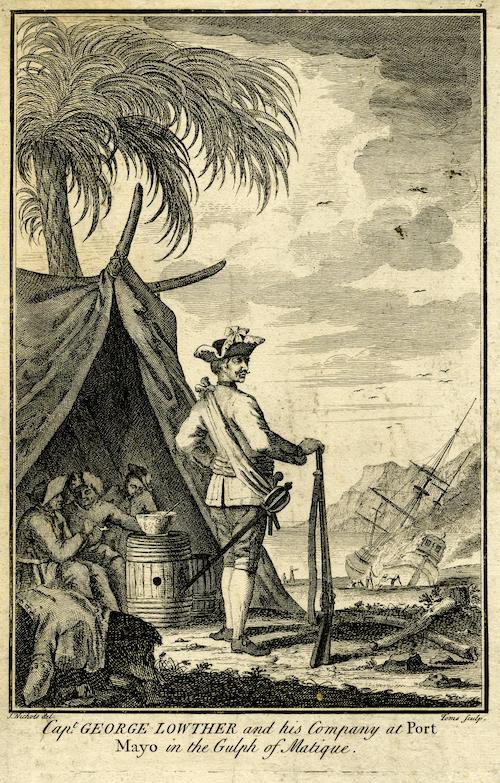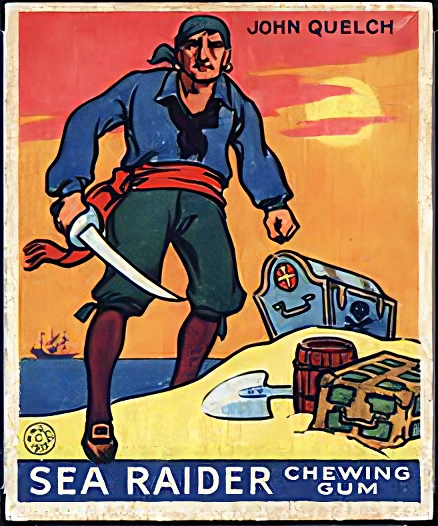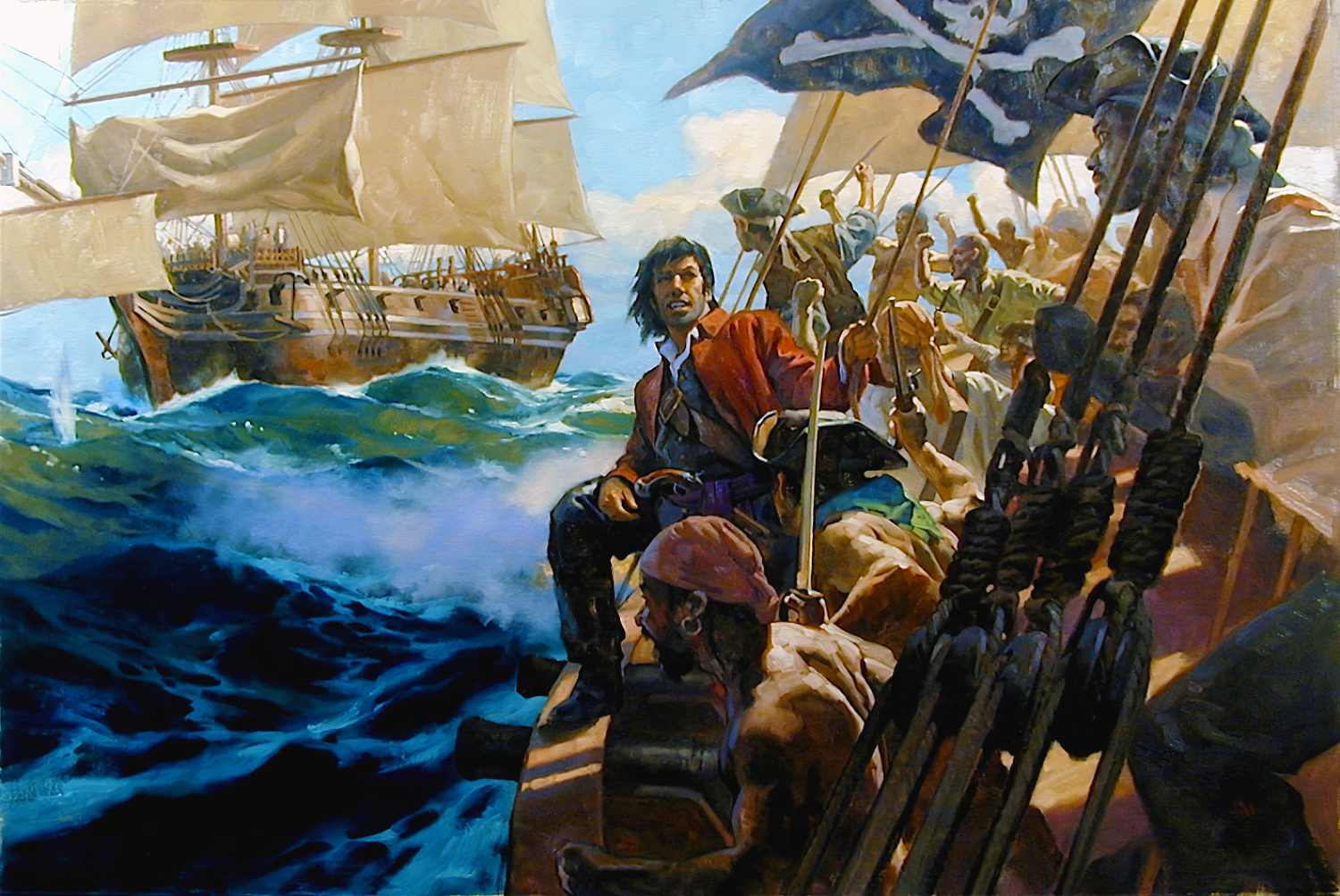Were Pirates Sea Robbers?

Usually, when people refer to “pirates,” they mainly think of the individuals who engage in violent acts at sea. This is popular among pirate myths. But pirates often went further than this and used sophisticated overland trips to steal from cities and forts on land.
- Were Pirates Sea Robbers?
- Was Piracy a Man’s Profession?
- Did the Pirates Disregard the Law?
- Did Pirates Have No Fear of God? (Or Devil)?
- Did Every Pirate Ship Fly a Skull and Crossbones Flag?
- Did Pirates Carry a Parrot on Their Shoulders?
- Were the Pirates Bloodthirsty and Ruthless?
- Is It True That Pirates Were Very Rich and Buried Their Treasures in the Ground?
At the start of the 16th century, Muslim pirate Hayreddin Barbarossa ravaged the coasts of Spain, Portugal, and other Mediterranean countries like Tunisia and Algeria. The real-life Captain Henry Morgan, from whom Sabatini drew inspiration for his fictional hero Captain Blood in The Odyssey of Captain Blood, was himself an expert in long-distance journeys.
When he and 700 of his troops attacked Port-au-Prince in Cuba, they surprised everyone by coming from inland. The Panama Expedition led by Morgan is also well known; after seizing the fortified port of Portobello, he abandoned his ships in the harbor and set forth across the Isthmus of Panama with a force of between 1200 and 1800 men. His target was Panama City, the colony’s most populous and prosperous metropolis. The nine-day journey through the bush was treacherous. Morgan’s soldiers, however, not only held out, but also launched the attack that led to the city’s capitulation and subsequent pillaging.
Was Piracy a Man’s Profession?

One of the popular pirate myths is that pirates were only men. French King Philip VI had Count Olivier IV de Clisson beheaded in 1343 after he was apprehended in Paris on charges of collaborating with England to overthrow the French monarchy. His widow, Jeanne de Clisson (or Belleville), resolved to take revenge on the French monarchy.
Jeanne mortgaged her property and sold her jewels to equip warships, and then she sailed the seven seas as a commander. She actively hunted down and sunk French commerce ships, killing crew members and attacking coastal towns. But eventually, Jeanne’s good fortune ran out, and she lost a ship and a son in a storm. She eventually made her way to England, where King Edward III backed her cause. After some time, Jeanne fitted up more ships and maintained her revenge on the French even after the death of Philip VI. She stopped just a few years later, when she married again, this time to a commander in the English military.
Anne Bonny, an Irish lady who was born in 1700, is often regarded as the era’s most infamous female pirate. She was the product of an affair between a prominent attorney and his servant. The family was forced to leave their home in Europe and settle in the American colonies because of the controversy. Since her father had purchased estates in the area, Anne spent her childhood in the opulence of a large colonial mansion, complete with maids and a large staff.
Unfortunately for her parents, she was born with an iron will. There are tales of how she used to ride about town while naked and how she once attacked a maid. Young Anne eloped with an English sailor. The marriage was short-lived; she quickly found a new husband—John Rackham, a pirate renowned on America’s East Coast and dubbed Calico Jack—and became his right-hand man for his planning talent and daring in combat.
In the Caribbean, Jack and Anne were notorious pirates. In 1720, they encountered a heavily equipped British fleet and were forced to fight before being captured. The court condemned Anne to death, which was postponed since she was pregnant. Anne’s fate was unknown after the execution was postponed several times for unknown reasons.
Similarly, another pirate, Mary Read, is often mentioned in the same breath as Anne Bonny. From an early age, Mary would disguise herself as a man, first to inherit an estate and later to enlist in the British armed forces. The next year, in 1720, she hooked up with Anne and Jack and went on a plundering adventure with them. They were probably tried jointly in the end as well.
Women were also among the pirates in the East. Zheng Yi Sao (or Shi Yang) was feared by everyone who sailed the Chinese waters at the end of the eighteenth century. She was married to pirate admiral Zheng Yi and they were husband and wife who oversaw six squadrons. Zheng Yi Sao was a lieutenant in one of the squadrons before her husband’s murder and after that she began to hold his position.
Did the Pirates Disregard the Law?

According to one significant pirate myth, pirates always disregarded the law. However, many pirates were once employed on commercial or military vessels. Discipline on such ships was enforced by the commanders’ use of the stick. Sailors were subjected to flogging, keeling, and shackling. Many times, the captain and his crew would take money meant for the food and keep it for themselves. The average sailor had no influence whatsoever. It should come as no surprise, then, that once the pirates had control of a ship, the first thing they did was “administer justice” to the crew.
Pirates, in contrast to military seamen, were not restricted in their freedoms. They were free to disembark at any port of call or transfer to another vessel. Each pirate crew had its own set of rules and regulations. All positions, including the captain’s, were up for election, so there was no ultimate authority in the role. At the meeting, everyone had the chance to vote on various issues. The leader of the ship ate with the rest of the crew at the communal table. Frequently, he did not even have his cabin. There was a deep bond of brotherhood among the pirates. Not only did they frequently switch vessels, but it was also common practice for crews from various ships to form or break up. Because of this, often a new subculture would develop among the pirate crew.
Pirates in the new world had explicit legal protections that did not exist in the old world. The captain and the crew agreed upon the terms of a contract that included the distribution of loot, the payment of medical bills, the establishment of a pension fund, and the allocation of assets upon the captain’s death. The pirates could get awards for valor as well. Another plan left the total unknown but tallied the shares as follows: private pirates got one share, the captain got two and a half, the navigator got one and a half, and the doctor got one and a half. For example, when the treasure from the flagship of pirate Sam Bellamy was brought to the surface in 1982, it was found that all items were broken or cut into pieces.
Within twenty-four hours of the end of the war, the pirates were obligated to return all of the booties to the common pot. Next, the group swore an oath on the Holy Scriptures. The crew, from the captain down to the cabin boy, would strip to the waist to check for hidden booties before dividing it up.
According to the crew code of 18th-century English pirate George Lowther, a private pirate could rest certain that he would not be abandoned in the case of injury: “Anyone who loses an arm or leg in combat is entitled to a settlement of 150 pounds sterling. He’s welcome to hang around with us for as long as he likes.” Nonetheless, the adage “No prey, no pay” remained true.
Did Pirates Have No Fear of God? (Or Devil)?
When it comes to pirate myths, sailing crews have a long-standing reputation for using obscene language, whether it is to mock the devil or insult a saint. The commanders of the English Royal Navy during the Age of Discovery were responsible for monitoring the speech of their crew members and administering appropriate punishments for inappropriate language use. When compared to them, the pirates’ level of blasphemy was quite low.
A priest would regularly provide meals on corsair ships (corsairs were basically licensed pirates). As with the rest of the crew, he was rewarded monetarily for his efforts. In addition, before dividing their booty, pirates took an oath on the Bible and frequently prayed, both at mealtime and before going into war. Additionally, theological conflict may have frequently accompanied political and economic motivations for sea robbery; for example, crews composed of French Huguenots, English Puritans, and Dutch Calvinists may have justified their acts by saying it was a war against Spanish Catholics.
The stereotype of pirates being superstitious is accurate. Some of the ship’s commanders even had astrologers on board to foretell the outcome of their missions. The majority of pirates were seen sporting a wide variety of amulets. It has been said that wearing earrings was a common practice among pirates as a talisman against shipwrecks. Earrings could also be a symbol of a pirate’s social standing or a valued possession. Pirates used to believe that wearing a woven gallows rope or a mummified hand off some gallows would help them avoid execution.
Having a lucky charm in the shape of an axe wasn’t a terrible idea. Also, the pirates didn’t kill or consume the seabirds because they thought the birds were possessed by the spirits of the dead. A crew led by Welsh ship physician and explorer Lionel Wafer (1640–1705) once attempted to transport the mummies of an Indian child back to England for study but were intercepted by pirates who claimed the ship’s compass would be inaccurate with the body on board and so tossed it overboard.

However, there were also examples of pirates who were fervent Christians. To provide just one example, once the French scoundrel Raveneau de Lussan captured a Spanish hamlet, he took his entire troop to the cathedral to hear the thanksgiving hymn “Te Deum,” and only then did he start setting fires and plundering the place (however, saving the images of saints and making sure that no church was damaged). A common pre-battle oath among pirates was a promise to give a portion of their loot to the church. They nonetheless pillaged monasteries and kidnapped priests and nuns.
The pirates, before their deaths, naturally prayed to God. John Quelch, a pirate, was hanged in 1704. His dying words were recorded as reading, “I am not afraid of Death, I am not afraid of the Gallows, but I am afraid of what follows; I am afraid of a Great God, and a Judgment to Come.“
Did Every Pirate Ship Fly a Skull and Crossbones Flag?

A list of the pirate myths would not be complete without the Jolly Roger flag. Towards the conclusion of the so-called “golden period of piracy,” in the 1710s and ’20s, pirates did frequently fly a black flag depicting a skull and crossed bones or swords. The name “Jolly Roger” or “Old Roger” was given to this flag at that time. Aside from being black, the design in question was one of many options; there was no “official” version.
This flag is described in detail in “General History of the Robberies & Murders of the Most Notorious Pirates,” written by Charles Johnson and published in London in 1724. For example, in 1721, the banner of Bartholomew Roberts (aka Black Bart) portrayed a pirate and a skeleton with a dart in his hand clutching an hourglass. One iteration of his flag had a pirate with a knife standing on two skulls with the initials ABH and AMH; another had the pirate slashing through the skulls. In several other depictions, a skeleton with a spear is shown either piercing a heart or threatening to do so. As a final touch, a saber or a hand holding a saber was frequently seen.
Regarding the color black, pirates had been using the plain black flag without any design from at least the start of the 17th century, and it was still in use at the start of the following century along with the other modifications. In the 1720s, British warships would assault a vessel just for flying a black flag. Red flags were traditionally associated with pirates, although black ones were used rather frequently in the past. One theory is that the term “Jolly Roger” was derived from the French phrase “Joli Rouge,” which translates to “Pretty Red.”
According to other stories, aboard the same pirate ships, the black flag was worn by default and the crimson (“bloody”) flag was hoisted when the pirates proved that there would be no pity for anyone who did not surrender freely. A secret British report from the 1720s said that the most popular pirate flag was a black skeleton on a yellow background. This made it easy to mistake for the Holy Roman Empire’s flag, which had a black eagle on a yellow background.
In other words, there was no such thing as an “official” pirate flag; however, the use of black, red, and orange along with images of skulls, skeletons, hearts, spears, hourglasses, and swords was widespread. These flags were typically deployed at the outset of battle to let the defenders know who they were up against and maybe coerce a surrender from them. It was not uncommon for pirate ships to sail under national flags or no flags at all.
Did Pirates Carry a Parrot on Their Shoulders?
Pirates were particularly popular during a time when exotic pets and birds were in vogue. People in Europe eagerly paid high prices for parrots. Bright plumage and low upkeep appealed to them. There were marketplaces in London where people could purchase and sell birds, such as the one in Leadenhall. Specifically, the Veracruz area of Mexico was a major source for imported parrots. Bringing birds to England wasn’t too challenging because they didn’t eat a lot and their food wouldn’t go bad on the boat (nuts and seeds). Therefore, parrots could be useful to pirates not only as companions but also as a source of revenue. Historiographers, however, have not been able to confirm the existence of any pirate who carried a parrot on his shoulder. And this is one of the most common pirate myths.
Even so, it is well known that cats were kept on pirate ships by the pirates themselves for both luck and to keep rodents away.
Were the Pirates Bloodthirsty and Ruthless?

Pirates have a bad reputation for being villains who brutally kill hostages and destroy or burn ships. And there have been some notable names among them. If you were ever to face the French François l’Olonnais or the pirate Edward Law, you’d fight to the death since you’d know you wouldn’t get any pity from any of them.
Numerous eyewitnesses, seemingly kept alive on purpose to develop the requisite reputation, consistently described cases of atrocities and torture. The pirates’ intimidation of their would-be victims made them helpless to put up resistance, which aided the capture of their ships. To escape torture and death, it was preferable to submit and hand over all valuables. The pirates prioritized avoiding conflict wherever possible due to the cost to their resources and personnel.
Thus, this is a pirate myth as well. Remember that the pirates’ economic goal was to plunder and enslave the local populace, either to use them as pirates themselves or to resell as slaves. It was common practice to beat captured crew members. Whether they were merchant ships or fishing boats, valuables were seized and property was tossed overboard.
American piracy historian and scholar David Moore said this about Edward Teach, who was known as Blackbeard and was the model for Captain Flint in Robert Louis Stevenson’s Treasure Island: “There are no records to show that Blackbeard ever killed anyone except in a final fight, and even then, it can be shown that he was mostly on the defensive.”
Is It True That Pirates Were Very Rich and Buried Their Treasures in the Ground?
One of the most common pirate myths is that pirates were wealthy and frequently buried their treasures. Although some pirates were rumored to be extremely wealthy, common crew members sometimes went without basic necessities in old age (assuming they didn’t die on the gallows, that is). In addition, the majority of the loot consisted of food and other supplies that needed to be sold. In addition, most pirates didn’t worry much about what the future held and frequently went broke because they frivolously spent their money on things like alcohol, women, gambling, expensive clothing, and other luxuries.
Bibliography:
- Mozheiko I. V. Pirates, corsairs, raiders. Essays on the history of piracy in the Indian Ocean and the South Seas (XV-XX centuries). М., 1991.
- Hanke H. Sailor, Death and the Devil. М., 1989.
- Constantine S. The Pirate, the Governor and the Secretary of State: Aliens, Police and Surveillance in Early Nineteenth-Century Gibraltar. The English Historical Review. Vol. 123. № 504. Oxford University Press, 2008.
- Johnson C. A General History of the Pyrates, from Their First Rise and Settlement in the Island of Providence, to the Present Time. London, 1724.


